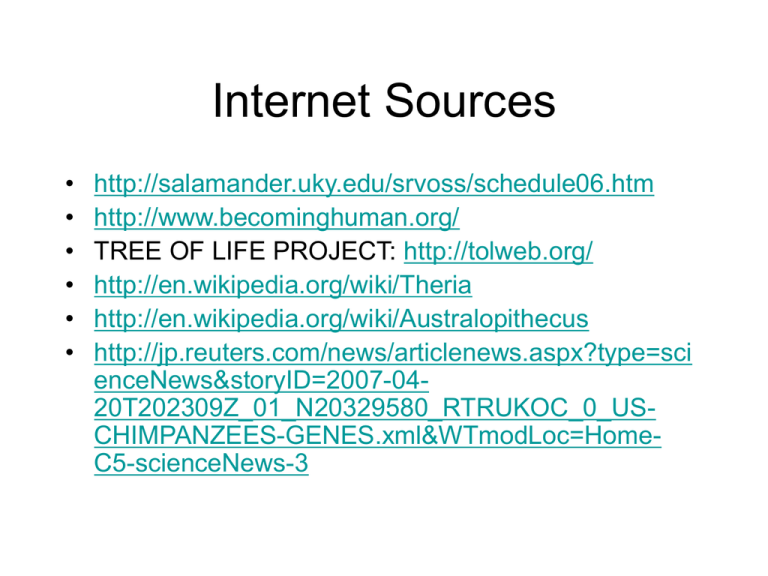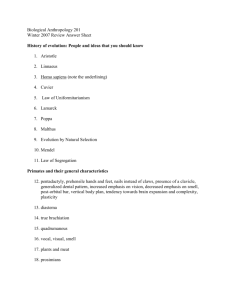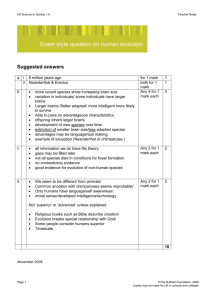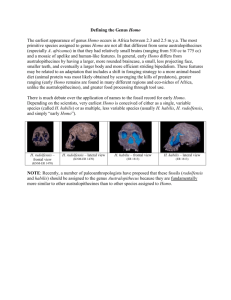
Internet Sources
•
•
•
•
•
•
http://salamander.uky.edu/srvoss/schedule06.htm
http://www.becominghuman.org/
TREE OF LIFE PROJECT: http://tolweb.org/
http://en.wikipedia.org/wiki/Theria
http://en.wikipedia.org/wiki/Australopithecus
http://jp.reuters.com/news/articlenews.aspx?type=sci
enceNews&storyID=2007-0420T202309Z_01_N20329580_RTRUKOC_0_USCHIMPANZEES-GENES.xml&WTmodLoc=HomeC5-scienceNews-3
Mammals
• Mammals- share characteristics with other
mammals such as: vertebrate with a spinal
chord, skeleton, skull housing a large brain,
ability to give birth to live offspring, mammary
glands, hair or fur, and common ancestry.
Phylogeny for the Class Mammalia Infraclasses
• Mammals- share characteristics with other
mammals such as: vertebrate with a spinal
chord, skeleton, skull housing a large brain,
ability to give birth to live offspring, mammary
glands, hair or fur, and common ancestry.
Phylogeny for Placental Mammals - Orders
Phylogeny for Primates –
Parvorders and Families
Similarities and Differences Between
Humans and Other Mammals
• Teeth
– canines - for tearing and piercing (most carnivores)
– incisors - nip and cut food (rodents)
– premolars with cusps - grinding and crushing (horses)
– molars with cusps - grinding and crushing (cattle)
– Early and more primitive mammals have 66 teeth; modern
mammals have 44; humans have 32.
– The incidence of Wisdom teeth appear to be diminishing
(natural selection?) in human populations (in Central Europe,
one or more wisdom teeth are missing in 19% of
population. Wisdom teeth or third molars are common among
Native Americans, but not among Africans).
• Offspring have an extended period of learning.
• Humans have an overall larger brain size.
• Humans possess behavioral flexibility
TRENDS IN PRIMATE EVOLUTION
•
•
•
•
•
•
•
Change in overall skeletal structure and mode of locomotion bipedalism (able to move on 2 appendages for extended periods of
time; with minimum energy loss).
Modification of hands - humans can cup hands and possess a
opposable thumb.
Less reliance on sense of smell and more reliance on sense of daytime
and color vision, and depth perception.
Change in dentition - primates moved from eating insects to more fruits
and vegetables to becoming omnivorous - adaptation of teeth is
probably caused by natural selection, so that the kinds of teeth best
able to accommodate a particular diet become enhanced over time.
Brain expansion - more elaborate.
– Gorilla 600 cm3
– Humans 1350 cm3
Higher intelligence may have resulted from tool making, need for better
memory, or to increase ability to anticipate jumps (from branch to
branch) or throws (weapons and spears). Once you let go of
something, you don't have any way to control its motion.
Behavioral and cultural evolution- ability to learn and mimic
behavior. ex. language.
Common
Ancestor or
Direct
Descendent?
Common
Ancestor or
Direct
Descendent?
Common
Ancestor or
Direct
Descendent?
Humans and Chimpanzees
•
Morphologically humans and apes are distinct from one another.
– Based on molecular data, isozyme polymorphisms and sequences
of mitochondrial and genomic DNA, humans and apes, in particular,
chimpanzees are quite similar.
– Humans and chimpanzees share 52 % of the same alleles.
– Humans and Chimpanzees share the same Blood Type
Phenotypes (ABO SYSTEM)
– Nucleic acid differences are even less, 1.1 percent difference.
•
Was the common ancestor to humans and chimpanzees separated by
the Great Rift Valley in Africa, leading to allopatric speciation? Humans
probably evolved in response to changing environmental conditions as
forests gave way to savannas. Some evidence supports this
hypothesis, but it is far from conclusive.
•
According to the Chimpanzee Genome Project, both human (Ardipithecus,
Australopithecus and Homo) and chimpanzee (Pan troglodytes and Pan
paniscus) lineages diverged from a common ancestor about 5-6 million years
ago, if we assume a constant rate of evolution.
Gene study shows
chimps more diverse
than humans
By Maggie Fox, Health and Science Editor
WASHINGTON (Reuters) - They may all be black and hairy
and they may all eat and act in much the same way,
but chimpanzees from different parts of Africa are
genetically more diverse than all of humanity,
researchers reported on Friday.
Experts have long marveled that older ideas of race are not
reflected in human DNA. Genetic diversity is more
pronounced within population groups than between
them, with only a few gene differences accounting for
the wide variations seen in eye, skin and hair color
across humanity.
So animals all about the same size and color and showing
few behavioral differences must be even more
genetically identical, right?
Wrong, says Molly Przeworski, assistant professor of
human genetics at the University of Chicago.
Her team looked at the DNA of the three designated
populations of chimpanzees in Africa -- the eastern,
western and central populations, designated by some
researchers as sub-species of the chimpanzee.
They found that a western chimpanzee has more
differences, genetically, from an eastern chimp than
any one human being has from another.
"It is the first genetic confirmation that they are distinct
populations," Przeworski said in a telephone interview.
"I stay away from the word
'subspecies'." Continued...
© Reuters 2007. All Rights Reserved.
Bonobo apes, primates unique
to Congo and humankind's
closest relative, groom one
another at a sanctuary just
outside the capital Kinshasa, in
this October 31, 2006 file photo.
They may all be black and hairy
and they may all eat and act in
much the same way, but
chimpanzees from different parts
of Africa are genetically more
diverse than all of humanity,
researchers reported on Friday.
REUTERS/Finbarr O'Reilly
Trends in Homo Evolution
• Increase in brain volume
• Increase in size
• Skull evolution : vertical face, smaller jaw,
round forehead
• Bipedalism
• Tool development
• Cultural development
Our Understanding of Human Evolution is
Primarily Based on Fossils
“In each great region of the world the living mammals are
closely related to the extinct species of the same region. It
is , therefore, probable that Africa was formerly inhabited
by extinct apes closely allied to the gorilla and chimpanzee;
And as these two species are now man’s nearest allies,
It is somewhat more probable that our early progenitors
lived on the African continent than elsewhere.”
Charles Darwin
The Descent of Man, 1871
Raymond Dart with Taung skull
• Taung child, which was
discovered in 1924 in South
Africa.
• Taung child was originally
thought to be a fossil of a
child because of its small
size.
• An endocast of the brain
revealed fissures that were
more human-like than apelike.
• Australopithecus africanus or
“southern ape from Africa”
Robert Broom: One of Dart’s
Few Supporters
• In 1934, at the age of of 68,
Broom gave up his medical
practice to take a position at the
Transvaal Museum in Pretoria.
• In 1936, he decided to search
for more of Dart's
australopithecines.
• Broom recognized two types of
australopithecines: gracile and
the robust.
• In 1948 he started excavating at
Swartkrans, which yielded
remains of what was later
determined to be Homo erectus,
as well as further
australopithecine fossils.
Gracile
Australopithecines
Australopithecus
• 4.1 mya to 1.2 mya
• Bipedal
– Foramen magnum faces down
– 3.6 my footprints found in volcanic ash near afarensis
fossil
• Large projecting face, small brain case (400 cm3 )
• Small in stature (3’7’’ - 4’11’’ ft)
• Two distinct lineages (gracile and robust)
• May have developed tools
Homo
• 1.9 mya to present
• Larger braincases (cro-magnon: 1600
cm3) than australopithecines and smaller
face
• Smaller jaws and teeth
• Much taller than australopithecines
• Development of tools, culture, and
language
Slight Increase
In Body Size
Much Greater Increase
In Brain Volume
Braincase Volume and Body Mass
Gracile
Australopithecines
Robust
Australopithecines
Paranthropus
Gracile Australopithecines
Archaic Homo
Archaic Homo
Modern Homo
Summary of Hominid Evolution Since
the Chimp/Human Common Ancestor
•Frequent speciation produced a diversity
of species
•As many as 5 different species may have
coexisted at one time
•We are the lone survivors of an otherwise
extinct radiation of bipedal African hominids
What is the Origin of Modern Human
Populations?
• Multiregional Hypothesis
– Homo sapiens evolved from an ancient
stock of Homo ergaster/erectus that
originated in Africa (~ 1-1.8 mya)
• Out of Africa Hypothesis
– Homo sapiens evolved from a relatively
recent stock of archaic sapiens that
originated in Africa (~ 30,000-200,000
ya)
How Can We Test These Hypotheses With
Archaic and Contemporary Morphological Data?
• Multiregional Hypothesis
– Predicts greater morphological
similarity between archaic and modern
Homo within regions
• Out of Africa Hypothesis
– Predicts greater morphological
similarity between modern forms from
different regions than between modern
and archaic forms within regions
Morphological Evidence Is Inconclusive
I. Morphological Support for Multiregional Hypothesis
Frayer et al. 1993. American Anthropologist 95:14-50.
Li Tianyuan and D.A. Etler. 1992. Nature 357:404-407.
II. Morphological Support for Out of Africa Hypothesis
Liberman, D.E. 1995. Current Anthropology 36:159-197.
Waddle, D.M. 1994. Nature 368:452-454.
How Can We Test These
Hypotheses With Molecular Data?
• Multiregional Hypothesis
– Predicts that Homo sapien “eve”
existed more than 1 mya.
• Out of Africa Hypothesis
– Predicts that Homo sapien “eve”
existed ~ 30,000-200,000 yr ago.
Molecular Clock Estimate of
Divergence Time of Modern Humans
Gene
Estimate
mt DNA
mt DNA
nuclear DNA
mt DNA
nuclear DNA
166-249,000
129-536,000
75-287,000
125-161,000
102-450,000
Reference
Vigilant et al., 1991
Ruvolo et al., 1993
Bowcock et al., 1994
Horai et al., 1995
Tishkoff et al., 1996
Finally, what about our
relationship to Neandertals?
PCR analysis of Neandertal
fossilized mtDNA suggest that
this was a species distinct
from Homo sapiens.
Neanderthals are distinct from Homo sapiens







